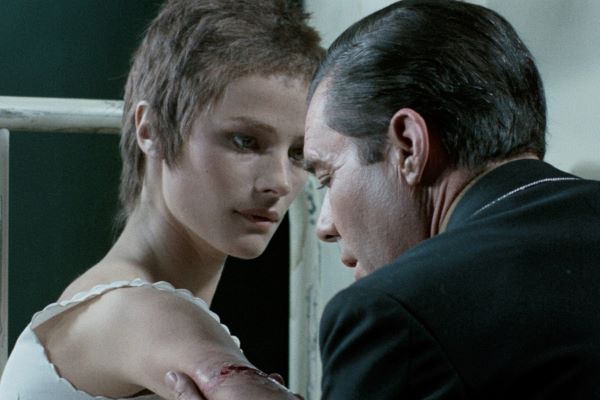The Night Porter caused consternation when it was first released. Most critics hated it. The New Yorker’s pithy Pauline Kael wrote that it proved that: ‘women can make junk just as well as men’. Films and Filming magazine (a forerunner to Sight and Sound, with a large gay readership) gloried in its decadence. And, well, then there was the poster. The ravishing Charlotte Rampling was captured topless in stormtrooper’s cap and long opera-gloves, hands cupping her breasts. The consternation was largely caused because of what was seen as the trivialising treatment of Nazi war atrocities. It had been 30 years since VE-Day and there were still, ‘don’t mention the war,’ sensibilities. Now, nearly 45 years after The Night Porter was released, how does this cult movie stand up?
It’s 1957, Vienna, and Max (Dirk Bogarde) is the shifty receptionist at a gloomy hotel. Strange people come and go. When an opera conductor arrives with his classy wife Lucia (Rampling) Max and the woman’s eyes lock. Some ten years previously they first met when she was a new, teenage arrival at a concentration camp and he, the camp doctor (as it were), who singled her out for unspeakable medical experiments (trimmed thankfully by the censors).
Unaccountably, Max and Lucia, the latter in a kooky concentration camp coupe sauvage hairdo, indulge in a co-dependent love affair. Back in ’57 Lucia’s shocked reticence gives way to morbid passions as she and Max get it on once again. There’s a subplot involving finding and neutralising witnesses to Max’s war crimes and thus, ‘liberating him from his past’. ‘To save someone’s skin, sometimes there’s no price too high,’ the audience is cryptically informed.
Suffice to say the bulldozers have been out piling on the decadence: Lucia smoking a pipe, long leather trench coats, a dude in a monocle, semi-nudity, Max’s Siamese cat, Nazi salutes on windy rooftops, S&M, Rampling’s cut-glass profile endlessly being slapped. Fans of Bogarde’s turn as the creepy gentleman’s gentleman in Joseph Losey’s The Servant will relish his reprise here.
The whole pottage is so self-consciously arty it’s almost satire. The pop video aesthetics are so acute you’re half expecting Midge Ure to appear warbling about Vienna in the background. Combine this with some appalling post-dubbing and you really feel the subject matter (done much better in The Reader of 2008) deserved far better. It’s stiffly plotted, with director Cavani seeming to give up on it at halftime. Things only breathe when Bogarde and Rampling are together on the screen. At root the film lacks all seriousness and that is its biggest failing.
At any point did Dirk or Charlotte wonder what they had got involved in? Not according to Ms. Rampling in an extras interview where she witters on earnestly about loving interesting, serious scripts. For Bogarde’s part this was a pet project but then he was a closeted gay man until they day he died who had a thing about leather and motorbikes. One of the films memorable posters featured a quote from a review: ‘What a kinky turn-on!’ What a kinky turn-off.
Available on Blu-ray from Mon 30 Nov 2020
